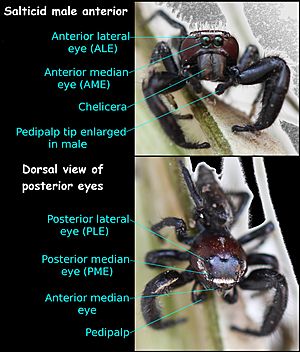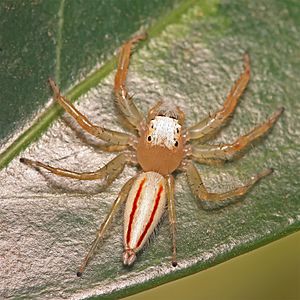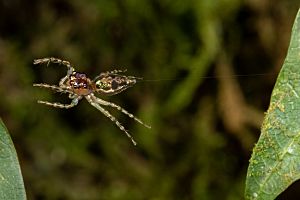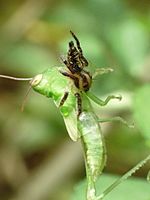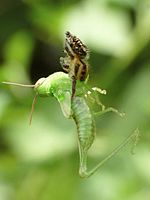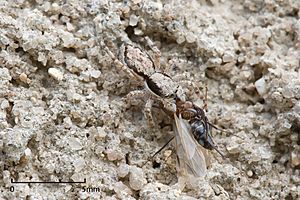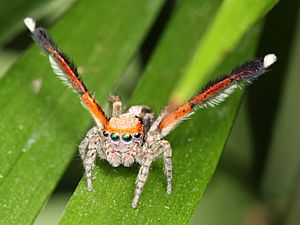Jumping spider facts for kids
Quick facts for kids Jumping spiders |
|
|---|---|
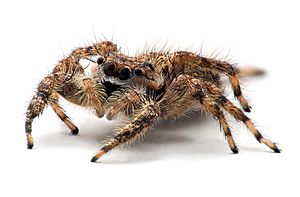 |
|
| Adult female Platycryptus undatus | |
| Scientific classification |
|
| Kingdom: | Animalia |
| Phylum: | Arthropoda |
| Subphylum: | Chelicerata |
| Class: | Arachnida |
| Order: | Araneae |
| Infraorder: | Araneomorphae |
| Family: | Salticidae Blackwall, 1841 |
| Genera | |
|
See List of Salticidae genera. |
|
| Diversity | |
| 600+ genera, 6000+ species | |
 |
|
Jumping spiders are a special group of spiders. They belong to the family called Salticidae. There are over 6,000 different kinds, or species, of jumping spiders. This makes them the biggest family of spiders on Earth! They make up about 13% of all known spider species.
Jumping spiders have amazing eyesight. It's one of the best among all arthropods (like insects and crabs). They use their sharp vision to find partners, hunt for food, and move around. Even though they usually move slowly, most species can make very quick and agile jumps. They jump when they are hunting, escaping danger, or crossing big spaces.
These spiders have eight eyes. The two large front eyes are especially noticeable. They also have two ways of breathing, using both book lungs and a tracheal system.
Contents
What Makes Jumping Spiders Special?
Jumping spiders are easy to tell apart from other spider families. You can recognize them by the shape of their body (called the cephalothorax) and their unique eye pattern. No other spider family has eyes quite like theirs.
Their legs do not have many big spines. The four front legs are usually bigger than the four back legs. Even so, jumping spiders use their back legs to jump. Their larger front legs help them grab prey. In some species, these front legs and their pedipalps (small leg-like parts near the mouth) are used to signal to other spiders of the same kind.
Their Amazing Eyes
The eye pattern is the clearest way to identify a jumping spider. They have eight eyes in total. The two large front eyes (called anterior median eyes) are great for seeing details and in 3D. This helps them figure out how far away their prey is. This way, they can jump with great accuracy. The eyes on the sides of the front (anterior lateral eyes) give them a wider view of what's in front.
The four eyes at the back are arranged in two rows. The two large back eyes (posterior lateral eyes) are the furthest back. They help the spider see to the sides. The two smaller middle back eyes (posterior median eyes) are also moved to the sides. Scientists are not sure if these smaller eyes work in many species.
Jumping spiders can be tiny, about 1 millimeter (0.04 inches) long, or quite large, up to 25 millimeters (1 inch) long. Some of the biggest kinds include Hyllus giganteus, Phidippus, Philaeus, and Plexippus.
Silk and Shelter
Jumping spiders use their silk for safety lines when they jump. They also build small silk "pup tents." These tents protect them from bad weather. They also sleep in them at night. Spiders use these shelters to shed their skin (molt), store their egg cases, and spend the winter.
Their bodies have special hairs that can hear sounds from up to 3 meters (10 feet) away.
How Jumping Spiders See the World
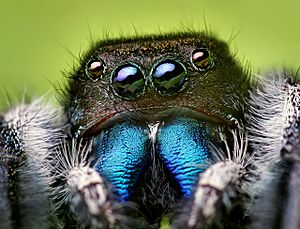
Jumping spiders have four pairs of eyes. Three pairs are fixed, meaning they don't move. One main pair can move.
The posterior median eyes (PMEs) are very small in many species. They can't form clear pictures. Scientists think they might help the spider sense light from the sky, like insect ocelli do. These eyes can see blue and UV light.
The posterior lateral eyes (PLEs) help the spider sense movement from the sides and behind. With all their eyes working together, jumping spiders have a nearly 360-degree view of their surroundings.
The anterior lateral eyes (ALEs) have the best vision among the fixed eyes. They can see some details. If a spider only uses its ALEs, it can still find, stalk, and attack flies. These eyes are also far enough apart to give them stereoscopic vision, which helps with depth.
The anterior median eyes (AMEs) have very sharp vision. These two eyes are like small telescopes. They have a lens at the front and another at the back. These lenses focus images onto a special four-layered retina. These eyes might have four different types of cells that can see different colors, including ultraviolet (UV) light. This means they might have tetrachromatic color vision.
Since these eyes are very close together, they can't use normal depth perception. Instead, they use a trick called "image defocus." One layer of their retina sees a clear image, while another sees a blurry one. By comparing the clear and blurry images, they can figure out how far away objects are. Some species, like Cosmophasis umbratica, can see UV light and use it to find mates.
The AMEs have high resolution, but they only see a narrow area. However, the spider can move its retina inside the eye. This lets the spider scan objects without moving its whole head. This is similar to how humans move their eyes to focus on things. You can even see these eye movements from outside the spider if its body is clear!
How Jumping Spiders Behave
Amazing Jumps
Many other creatures can jump, like grasshoppers and fleas. But jumping spiders are special because they can make very accurate, targeted jumps. They jump to move around, escape danger, and catch prey.
Jumping spiders have a strong internal "hydraulic" system. They use the pressure of their body fluid (called hemolymph) to extend their legs. This allows them to jump without needing huge muscles like a grasshopper. Some species can jump two or three times their body length. One spider, a Colonus puerperus, was even measured jumping 38 times its own body length! Their excellent vision helps them make these jumps so precisely.
Before a jumping spider jumps, it attaches a silk thread (called a 'dragline') to where it is standing. This dragline helps them brake and stay steady. If the jump doesn't go as planned, the spider can climb back up its silk line.
Clever Hunters
Jumping spiders hunt during the day, which makes sense because of their great eyesight. When a jumping spider spots something it might want to eat, it turns its body to get a good look with its main front eyes. Then, it lines up its back body part (abdomen) with its front body part (cephalothorax).
The spider might spend some time watching the prey to make sure it's good to eat. Then, it slowly creeps forward. When it's close enough, the spider attaches a silk safety line. Finally, it springs onto its prey!
Jumping spiders can be very smart hunters. They don't always go straight for their prey. Sometimes, they take a long, winding path, even if they can't see the prey for a bit. This complex behavior is amazing for an animal with such a tiny brain! Some Portia spiders, for example, can go down one bush, across the ground, and up another bush just to catch a specific insect. Scientists are still studying how they do this.
Some jumping spiders are always on the move, stopping often to look for prey. Others prefer to sit in one spot and scan their surroundings. Then, they actively stalk any prey they see. Spiders in the Phaeacius group are extreme sit-and-wait hunters. They sit on tree trunks, facing down, and just lunge at anything that passes by.
Some Salticidae spiders specialize in eating certain prey, like ants. Most spiders avoid ants, but several jumping spider species eat them often. They even have special ways to attack ants. For example, Anasaitis canosa circles around to the front of an ant and grabs it from behind its head. These ant-eating spiders will still catch flies and other prey in the usual way, but they take extra care with dangerous ants. Ants are a good food source because there are many of them, and not many other predators eat them.
Some of the most surprising hunting behaviors are seen in jumping spiders that hunt other spiders. Many of these spiders attack other spiders just like any other prey. But some will invade other spiders' webs. Spiders like Phidippus audax sometimes steal prey caught in webs. They might even jump onto and eat the web's owner!
Spiders in the genera Brettus, Cyrba, Gelotia, and Portia are very good at invading webs. They slowly move onto the web and vibrate the silk with their pedipalps and legs. If the web's owner comes to check on the vibrations (thinking it's trapped prey), the jumping spider attacks.
Most jumping spiders are active hunters and don't build webs to catch food. However, there are exceptions. Some Portia species build unusual funnel-shaped webs that are good at catching other spiders. Spartaeus spiders mostly catch moths in their webs. Scientists wonder if building webs is something these spiders still do from their ancestors, who might have built webs more often.
Jumping spiders also use their silk to reach prey that would otherwise be too far away. For example, they can jump towards prey, then swing back on their silk line. This lets them leap onto prey on vertical surfaces or even upside down.
Once they touch their prey, jumping spiders bite quickly. They inject a fast-acting venom that paralyzes the victim almost instantly. This is similar to how some other spider families hunt, as they don't use silk to wrap up their prey first.
What Jumping Spiders Eat
Even though jumping spiders are mostly meat-eaters, many species also drink nectar from flowers. One species, Bagheera kiplingi, mostly eats plants! No jumping spiders are known to eat seeds or fruit. Plants with special nectar glands, like the partridge pea, provide nectar to jumping spiders. In return, the spiders help the plant by eating pests they find.
The female of a Southeast Asian species called Toxeus magnus feeds her babies a milky, nutritious fluid for the first 40 days of their lives.
Reproduction and Life Cycle
Courtship and Mating Behavior
Jumping spiders have complex ways of finding a mate. Males perform special dances and show off their bodies. Males often have colorful or shiny hairs, special fringes on their front legs, or other unique body parts. These features are used in a courtship "dance" to attract females. For example, the peacock spiders are famous for their amazing colors and dances.
Besides showing off colors, male jumping spiders do complex sliding, vibrating, or zigzag movements. Many males also make sounds, like buzzing or drumming, to get the female's attention. The way they court varies a lot between different species.
Their ability to see UV light (as mentioned in the Vision section) is important for courtship in some species. For example, male Cosmophasis umbratica spiders have markings that only show up in UV light. Females use these markings to choose a mate.
If a female is interested in the male, she will crouch down and stay still. In some species, she might vibrate her palps or abdomen. The male then reaches out his front legs to touch her. If she remains still, the male climbs onto her back and mates with her using his palps.
Why Males are So Colorful
Having bright colors or special decorations helps male spiders attract females. But there's a downside: being colorful can also make them easier for predators to spot and catch. So, it's a balance between attracting a mate and staying safe.
Where Jumping Spiders Live
Jumping spiders live in many different places around the world. Most species are found in tropical forests. But you can also find them in temperate forests, scrubland (bushes and shrubs), deserts, intertidal zones (where the ocean meets land), and mountains. One species, Euophrys omnisuperstes, has been found at the highest elevation, on the slopes of Mount Everest!
Animals That Copy Jumping Spiders
Some small insects look or act like jumping spiders. Scientists think this helps them avoid being eaten, especially by jumping spiders themselves! For example, some flies called tephritid flies have patterns on their wings that look like spider legs. Some plant hoppers (fulgorids) and even some moths might also mimic jumping spiders.
Ancient Jumping Spiders
Very few fossils of jumping spiders have been found. All the known fossils are preserved in amber (fossilized tree sap) from the Cenozoic era. The oldest ones are from Baltic amber, dating back about 54 to 42 million years ago. Other fossil jumping spiders have been found in amber from Chiapas and the Dominican Republic.
Images for kids
See also
 In Spanish: Saltícidos para niños
In Spanish: Saltícidos para niños


